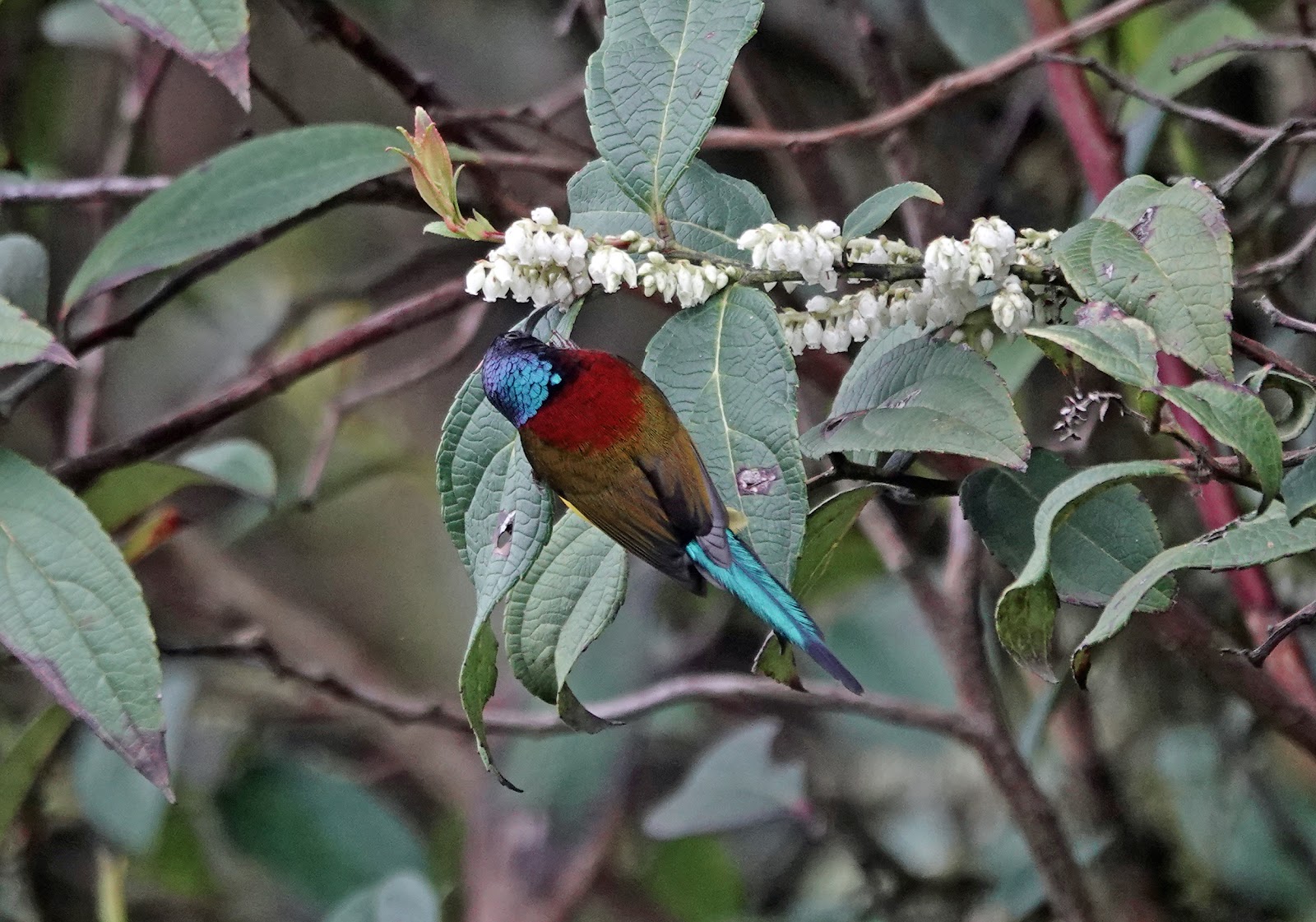Technically, Lama Camp is not actually in the Eaglenest Sanctuary. We had to drive up to reach the sanctuary and our next destination, Bompu Camp, about 30 km away. The road is called a jeep track. That is putting is nicely. I can't believe where we went in our vehicle, which was only two wheel drive. We had to gain a good bit of elevation and some of the road had sharp drop-offs.
But there was some other business to take care of first. We returned the trail where the others had seen the Bugun Liocichla the previous afternoon. Being my normal pessimistic self, I didn't have a lot of hope, but Dorjee and Mike quickly located three, including a very showy female. Instead of diving into the undergrowth, this one was, as my friend Matt Hale says, a real tart! She showed off for quite some time, allowing photos and even some video. I was greatly relieved. We had some other great birds near by, including Red-billed Leiothrix. (I dare you to try and pronounce Liocichla and Liothrix three times quickly after drinking a bottle of wine!)
The birds in this area can be incredibly difficult to see. This is understandable as even the small birds have been hunted for so long. Now the birds are protected in the sanctuary, but their instinct to hide is still strong. So many birds were skulking deep in the under-story. We would hear them singing just a few feet away, but only get quick glimpses. It was very frustrating at times. But some birds were very showy, particularly sunbirds. We had so many Green-tailed Sunbirds working the flowers we started sighing saying "It's another sunbird."
We crossed into the sanctuary and had a lot of interesting birds. An Ashy Wood-pigeon was a bit of a prize. A Yellow-cheeked Tit showed well. (I am resisting make a juvenile joke about a tit showing.) One of my favorite birds of the day, a Hoary-throated Barwing picked around on a mossy tree. It is not a rare bird, but I really loved the plumage. It is well named, with a pale throat and barred wings. We also had a Yellow-bellied Fairy-fantail, who has one of the best names ever!
We got to Bompu Camp at about 300PM. I was so excited to see someone had put up sheets with lights to study moths. Even though it was mid-day the sheets were still covered with bugs. We were surprised that the birds were not coming in and eating them. After we got into our tents, I climbed the hill and took way too many photos. Getting IDs on them is going to be fun. I am not going to start processing those photos until after I get my posts on the trip finished. Butterflies are hard enough to get identified. But there were some really cool moths there!
After we got settled in we went down hill from the camp to do some more birding. Again, most of the birds were very difficult to see, but we lucked out with a Chestnut-breasted Partridge, which is not an easy bird to get. We also had a gorgeous Red-headed Trogon. We heard a lot of good birds, like Himalayan Cutia, Long-billed Wren-babbler, Sikkim Wedge-billed Babbler, Slaty-bellied Tesia, a super cute bird that I really wanted to actually see. Our plan was to drive down that road the following morning, looking for some of the lower elevation birds. I could not wait!
Bompu was very similar to Lama Camp. We slept in tents with cots. There were western type toilets in the outdoor bathroom. It wasn't nearly as cold there. It had been wet and there was a lot of mud, but that wasn't difficult that difficult to deal with. We had a nip of whiskey, plugged in everything that needed charging when they turned on the generator, and had a very nice dinner. They even had dessert!
Photos from the day: https://www.flickr.com/photos/sngcanary/albums/72177720299163181
Bird list for the day:
1. Hill Partridge
2. Chestnut-bellied Partridge *
3. Ashy Wood-pigeon *
4. Wedge-tailed Green-pigeon *
5. Large Hawk Cuckoo
6. Lesser Cuckoo
7. Indian Cuckoo
8. Himalayan Cuckoo
9. Common Cuckoo
10. Red-headed Trogon
11. Great Barbet
12, Golden-throated Barbet
13. Bay Woodpecker
14. Black-winged Cuckoo-shrike
15. Black-headed Shrike-babbler *
16. Green Shrike-babbler
17. Black-eared Shrike-babbler *
18. Maroon Oriole
19. White-throated Fantail
20. Ashy Drongo
21. Gray-backed Shrike
22. Yellow-bellied Fairy-fantail
23. Gray-headed Canary-flycatcher
24. Green-backed Tit
25. Yellow-cheeked Tit
26. Russet Bush Warbler
27. Pygmy Cupwing
28. Gray-cheeked Warbler
29. Whistler's Warbler
30. Large-billed Leaf-warbler
31. Chestnut-crowned Warbler
32. Blyth's Leaf-warbler
33. Slaty-bellied Tesia
34. Black-faced Warbler
35. Brownish-flanked Bush Warbler
36. Black-throated Tit
37. Golden-breasted Fulvetta *
38. White-breasted Parrotbill *
39. Black-chinned Yuhina *
40. Whiskered Yuhina
41. White-naped Yuhina *
42. Stripe-throated Yuhina
43. Rufous-vented Yuhina
44. Golden Babbler
45. Rufous-throated Wren-babbler *
46. Coral-billed Scimitar-babbler
47. Sikkim Wedge-billed Babbler *
48. Yellow-throated Fulvetta *
49. Rufous-winged Fulvetta
50. Long-billed Wren-babbler
51. Striated Laughingthrush
52. Himalaya Cutia
53. Chestnut-crowned Laughingthrush
54. Beautiful Sibia
55. Hoary-throated Barwing *
56. Chestnut-tailed Minla
57. Rusty-fronted Barwing
58. Red-billed Leiothrix
59. Red-tailed Minla *
60. Bugun Liocichla
61. Gray-sided Laughingthrush
62. Gray-winged Blackbird
63. Rufous-bellied Niltava
64. Verditer Flycatcher
65.Blue Whistling-thrush
66. White-tailed Robin
67. Blue-fronted Redstart
68. Chestnut-bellied Rock-thrush
69. Green-tailed Sunbird
70. Orange-bellied Leafbird
71. Olive-backed Pipit
72. Common Rosefinch
73. Gray-headed Bullfinch *
Life birds marked with *










1 comment:
Surely I cannot be the only reader that was thrilled to read y our narrative and see these photos. Second best thing to actually being there. Thank you.
Post a Comment